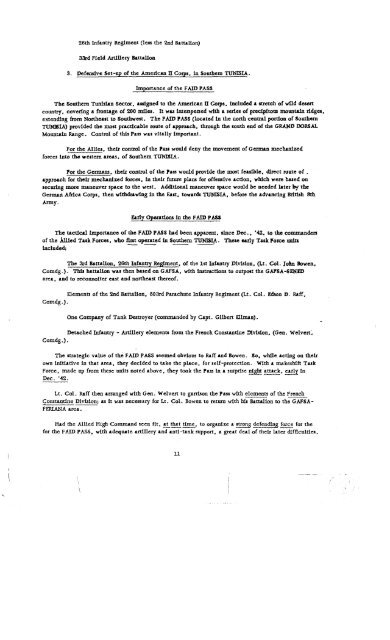KASSERINE PASS BATTLES Readings - US Army Center Of Military ...
KASSERINE PASS BATTLES Readings - US Army Center Of Military ...
KASSERINE PASS BATTLES Readings - US Army Center Of Military ...
Create successful ePaper yourself
Turn your PDF publications into a flip-book with our unique Google optimized e-Paper software.
26th Infantry Regiment (leas the 2nd Battalion)<br />
33rd Field Artillery Battalion<br />
3. Defensive Set-up_of the American II Corps, in Southern TUNISIA.<br />
Importance of the FAIR <strong>PASS</strong><br />
The Southern Tunisian Sector, assigned to the American II Corps, included a stretch of wild desert<br />
country, covering a frontage of 200 miles . It was interspersed with a series of precipitous mountain ridges,<br />
extending from Northeast to Southwest. The PAID <strong>PASS</strong> (located in the north central portion of Southern<br />
TUNISIA) provided the most practicable route of approach, through the south end of the GRAND DORSAL<br />
Mountain Range. Control of this Pass was vitally important .<br />
For the Allies , their control of the Pas: would deny the movement of Gemun mechanized<br />
forces into the western areas, of Southern TUNISIA .<br />
For the Germans , their control of the Pass would provide the most feasible, direct route of .<br />
approach for their mechanized forces, in their future plans for offensive action, which were based on<br />
securing more maneuver space to the west . Additional maneuver space would be needed later by tU<br />
German Africa Corps, then withdrawing in the East, towards TUNISIA, before the advancing British 8th<br />
<strong>Army</strong> .<br />
Early Operations in the FAIR <strong>PASS</strong><br />
_Task<br />
The tactical importance of the FAIR <strong>PASS</strong> had been apparent, since Dec. . '42, to the commanders<br />
of the allied<br />
included;<br />
Forces, who first operat ed in Southern TUNISIA. These early Task Force units<br />
The 3rd Battalion, 26th Infantry Regiment , of the 1st Infantry Division, (Lt . Col. John Bowers,<br />
Comdg .) . This battalion was then based on GAFSA, with instructions to outpost the GAFSA-SENED<br />
area, and to reconnoiter east and northeast thereof .<br />
Elements of the 2nd Battalion, 503rd Parachute Infantry Regiment (Lt . Col . Edson D . Raff,<br />
Comdg .) .<br />
One Company of Tank Destroyer (commanded by Capt . Gilbert Ellma n) .<br />
Detached Infantry - Artillery elements from the French Coastantiae Division, (Gen . Welvert ;<br />
Comdg .) .<br />
The strategic value of the FAID <strong>PASS</strong> seemed obvious to Raff and Bowers . So, while acting on their<br />
own initiative In that area, they decided to take the place, for self-protection . With a makeshift Task<br />
Force, made up from these units noted above, they took the Pass in a surprise !~&Irt attack , arty in<br />
Dec . '42 .<br />
Lt . Col . Raff then arranged with Gen. Welvert to garrison the Pass with elements of the French<br />
Constantine Division ; as it was necessary for Lt . Col. Bowers to return with his Battalion to the GAFSA-<br />
FERIANA area .<br />
Had the Allied High Command seen fit, _at that time , to organize a s~ defending force for the<br />
for the FAIR <strong>PASS</strong>, with adequate artillery andanti-tank support, a great dal of their liter difficulties,

















